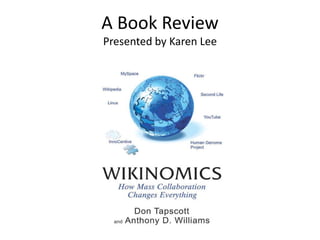Wikinomcs
- 1. A Book Review Presented by Karen Lee
- 2. Traditional business can now expand research and development capabilities to the global marketplace. Business can source and find specific individuals and groups who are motivated to solve problems or drive innovation.
- 3. Peer Production Self-organizing groups that come together voluntarily to produce a shared outcome. A flash mob is an example of co-creation and collaboration. Using social media, groups can like others who share the same goals or vision and mobilize them to connect.
- 4. Peer Production: Where it works 3 conditions: Object of production is information or culture, Tasks should be chunked into bite sized pieces Low integration costs Some examples: Wikipedia, Natural Sciences and the Pharmaceutical Industry and Airline Manufacturing
- 5. Ideagoras Make ideas, innovations, and scientific expertise around the planet accessible to innovation-hungry companies Innocentive is a leading Ideagora. It has access to over 90,000 scientists from 175 countries. Imagine the level of imagination, knowledge and expertise that can be used by connecting with this network.
- 6. Platforms for Participation Open Platforms: where various partners can build new businesses or simply add new value to the platform Platforms for participation will only remain viable for as long as stakeholders are appropriately compensated for contributions
- 7. The Wikinomics Playbook Wikinomics in action 26 distinct authors 40 page online publication After a call to action from Wikinomics authors, hundreds of participants collaborated together to create a body of text that further deepens Wikinomics understanding. Check out The Wikinomics Playbook online!
Editor's Notes
- Wikinomics is a business theoryWiki is a software that allows multiple users to edit simultaneouslyWiki here, is a metaphor for collaboration and co-creation
- A wiki is software that allows many users to editWikinomics is the practice and theory of collaboration.
- Best when 3 - Still is a need for peer review leaders who can guide and manage design rules for cooperation and motivate collective action over long periods of time
- Best when 3 - Still is a need for peer review leaders who can guide and manage design rules for cooperation and motivate collective action over long periods of time
- matchmaking system links experts to unsolved R&D problems - 90,000 scientists in 175 countries - Innocentive
- To really get participation, companies need to be willing to let others use their applications Example:Housingmaps which started by Paul Rademacher by combining google maps with apartment listings on craigslistGoogle saw this ingenuity and eventually hired Paul to the companyEspecially for small start ups, there is little incentive to keep up an application after creation. They don’t own the data (get it from somewhere else) and barriers to re-create application were low
